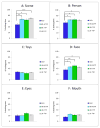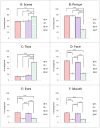Decreased spontaneous attention to social scenes in 6-month-old infants later diagnosed with autism spectrum disorders
- PMID: 23313640
- PMCID: PMC3646074
- DOI: 10.1016/j.biopsych.2012.11.022
Decreased spontaneous attention to social scenes in 6-month-old infants later diagnosed with autism spectrum disorders
Abstract
Background: The ability to spontaneously attend to the social overtures and activities of others is essential for the development of social cognition and communication. This ability is critically impaired in toddlers with autism spectrum disorders (ASD); however, it is not clear if prodromal symptoms in this area are already present in the first year of life of those affected by the disorder.
Methods: To examine whether 6-month-old infants later diagnosed with ASD exhibit atypical spontaneous social monitoring skills, visual responses of 67 infants at high-risk and 50 at low-risk for ASD were studied using an eye-tracking task. Based on their clinical presentation in the third year, infants were divided into those with ASD, those exhibiting atypical development, and those developing typically.
Results: Compared with the control groups, 6-month-old infants later diagnosed with ASD attended less to the social scene, and when they did look at the scene, they spent less time monitoring the actress in general and her face in particular. Limited attention to the actress and her activities was not accompanied by enhanced attention to objects.
Conclusions: Prodromal symptoms of ASD at 6 months include a diminished ability to attend spontaneously to people and their activities. A limited attentional bias toward people early in development is likely to have a detrimental impact on the specialization of social brain networks and the emergence of social interaction patterns. Further investigation into its underlying mechanisms and role in psychopathology of ASD in the first year is warranted.
Keywords: Autism; eye-tracking; infants at risk; social development; spontaneous monitoring; visual attention.
Copyright © 2013 Society of Biological Psychiatry. Published by Elsevier Inc. All rights reserved.
Conflict of interest statement
The authors report no biomedical financial interests or potential conflicts of interest.
Figures



Comment in
-
From attention to interaction: the emergence of autism during infancy.Biol Psychiatry. 2013 Aug 1;74(3):162-3. doi: 10.1016/j.biopsych.2013.05.018. Biol Psychiatry. 2013. PMID: 23845582 No abstract available.
References
-
- Interagency Autism Coordinating Committee. 2011 IACC Strategic Plan for Autism Spectrum Disorder Research. 2011 Jan; Retrieved from the Department of Health and Human Services Interagency Autism Coordinating Committee website at http://iacc.hhs.gov/strategic-plan/2011/index.shtml.
-
- Zwaigenbaum L, Thurm A, Stone W, Baranek G, Bryson S, Iverson J, et al. Studying the emergence of autism spectrum disorders in high-risk infants: Methodological and practical issues. Journal of Autism and Developmental Disorders. 2007 Mar;37(3):466–480. - PubMed
Publication types
MeSH terms
Grants and funding
LinkOut - more resources
Full Text Sources
Other Literature Sources
Medical

